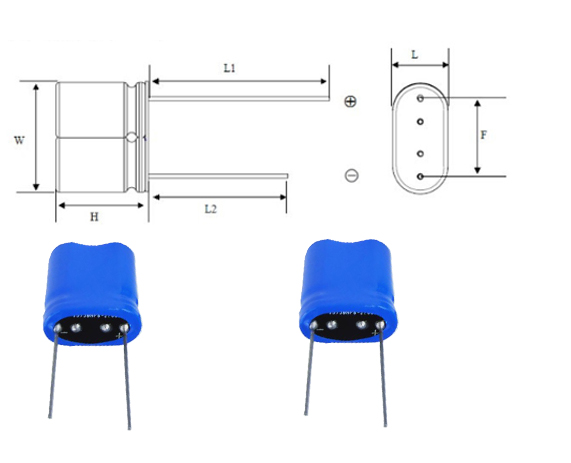Consulting phone:
135-3037-2041
(Mr.Wang)
Product introduction:
Pseudo-capacitor (Pseudo-capacitor) is a highly reversible chemical adsorption/desorption or oxidation/reduction reaction formed by the underpotential deposition of living materials on the surface of the electrode or in the two-dimensional or quasitwo-dimensional space of the bulk phase, resulting in capacitance related to the electrode charging potential, also known as Faraday quasi-capacitor; A typical pseudo-capacitor is composed of metal oxides, such as ruthenium oxide, and its specific capacitance is up to 760F/g. However, because ruthenium oxide is too expensive, cobalt oxide, nickel oxide and manganese dioxide have been used to replace it; Hybrid capacitor is composed of a half carbon electrode forming a double-layer capacitor and a half surface reaction of conductive polymer or other inorganic compound or electrode embedding reaction electrode. At present, there are carbon/nickel oxide hybrid capacitor products in the aqueous electrolyte system, and carbon/carbon (lithium ion embedded reactive carbon material), carbon/manganese dioxide and other hybrid capacitors in the organic electrolyte system are being developed.
Product specification:
| project | characteristic |
| Rated voltage | 5.5V |
| Capacity | 0.5F~25F |
| Working temperature | - 40 ℃ - 65 ℃ |
| Tolerance | 0+30% |
| Rated voltage | 5.5V |
| surge voltage | 5.7V |
| Temperature characteristics | from - 40 ℃ to 65 ℃ Capacity change: △ c ∠ 30% of initial measured value @ 25 ℃ Internal resistance change: △ ESR ∠ 100% of nominal value |
| Under high temperature load life of | 25 ℃ and rated voltage, load 1000h capacity change: △ c ∠ 30% of initial measured value @ 25 ℃ internal resistance change: △ ESR ∠ 200% of nominal value |
| Under normal temperature load life of | 25 ℃ and rated voltage, load capacity change in 10 years: △ c ∠ 30% of initial measured value @ 25 ℃ internal resistance change: △ ESR ∠ 200% of nominal value |
| Under normal temperature cycle life of | 25 ℃, after 500000 charge-discharge cycles (from rated voltage to 1/2 rated voltage), capacity change: △ c ∠ 30% of initial measured value @ 25 ℃ internal resistance change: △ ESR ∠ 200% of nominal value |
Product display:
Model | voltage V | capacity F | DC internal resistance m Ω | AC internal resistance m Ω | Leakage current uA72hrs | Weight g | L*W*H(mm) |
YKY | 5.5 | 0.5 | 800 | 420 | 0.008 | 2.6 | 16.7*8.5*15.4 |
5.5 | 1 | 520 | 280 | 0.010 | 3.5 | 16.7*8.5*22.3 | |
| 5.5 | 1.5 | 320 | 180 | 0.012 | 3.6 | 16.7*8.5*22 | |
| 5.5 | 2 | 120 | 40 | 0.013 | 3.75 | 16.7*8.5*22 | |
| 5.5 | 2.5 | 260 | 140 | 0.016 | 3.8 | 16.7*8.5*23 | |
5.5 | 3.5 | 180 | 130 | 0.02 | 4.6 | 16.6*8.5*31.8 | |
5.5 | 4 | 100 | 80 | 0.01 | 8.5 | 25.6*13*23.7 | |
5.5 | 5 | 140 | 100 | 0.03 | 7.8 | 25.6*13*23 | |
5.5 | 5 | 140 | 100 | 0.04 | 10 | 25.6*13*27.4 | |
| 5.5 | 9 | 100 | 70 | 0.05 | 9 | 25.6*12.5*25 | |
| 5.5 | 10 | 100 | 80 | 0.06 | 12 | 33*17*33 | |
| 5.5 | 15 | 80 | 64 | 0.10 | 13.5 | 37*17*33 | |
| 5.5 | 25 | 70 | 50 | 0.14 | 14.6 | 37*18*42 | |
| The above dimensions are not specified, and are customized according to requirements | |||||||
Product display:


Dimensions (unit: mm)

Application field:
1) Portable equipment: notebook computer, video camera, PDA, digital camera, portable DVD, etc 2) Household appliances: two-way radios, walkie talkies, electric toys, electric bicycles, emergency lighting 3) Military equipment 4) Medical treatment 5) Electric tools
![1677199467122442.png @K}RO@}2GS}O7])T_TR)23R.png](http://en.szsyky.cn/data/upload/202302/1677199467122442.png)
The double-layer supercapacitor module has the following advantages:
1. Green energy (activated carbon) does not pollute the environment.
2. Long service life (100000 times of charging); The lead-acid battery has a short life (500 times of charging), is easy to be damaged and difficult to manage. It is 20-200 times as long as the lead-acid battery and can share the same fate with the equipment.
3. Fast charging speed (0.3 seconds - 15 minutes); Lead-acid batteries have a long charging time (5-8 hours). Many batteries have a long charging time and a short driving range.
4. High charge-discharge efficiency (98%); The charge and discharge efficiency of lead-acid battery is low (70%);
5. High power density (10.000W/kg); The power density of lead-acid battery is low (300W/kg), more than 30 times worse.
6. Completely maintenance-free, operating temperature range (- 40~50); The driving range of lead-acid battery electric vehicles at - 40 ℃ is reduced by 90%, and the supercapacitor is only reduced by 10%.
7. In the electric bus, the energy recovery is strong, and the emergency braking energy recovery is up to 75%; The energy recovery of lead-acid batteries is only 5%, which is too important for public buses and can save a lot of fuel.
8. The relative cost is low. The price of supercapacitors is twice as high as that of lead-acid batteries, and the price will drop after mass production; However, the service life of supercapacitors is 10 times longer than that of lead-acid batteries, which is very important for the industrialization of public buses.
9. It has the function of over-temperature and over-pressure automatic alarm, which can better protect other equipment and ensure the normal operation of the equipment;